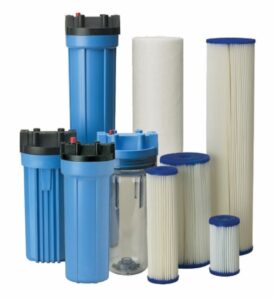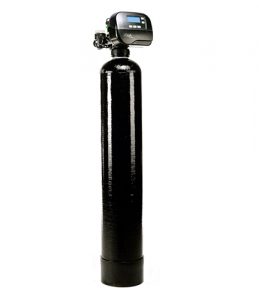
Turbid or Discolored Water
Turbid water is an observable characteristic of water. It is measured by the amount of light that is scattered by material in the water when a light is shined through it. The higher the intensity of scattered light, the higher the turbidity. Material that causes water to be turbid include clay, silt, very tiny inorganic and organic matter. Also, algae, dissolved colored organic compounds, plankton and other microscopic organisms may cause this. Higher levels of turbidity can sometimes be caused by water main breaks in public water supplies.

Various Sediment Filters
Excessive turbidity, discolor or cloudiness in drinking water is aesthetically unappealing, and may potentially represent a health concern. Turbidity can provide food and shelter for pathogens. If not removed, the causes of high turbidity can promote regrowth of pathogens in the water, leading to waterborne disease outbreaks. Turbidity is not a direct indicator of health risk. However, numerous studies show a strong relationship between removal of turbidity and removal of harmful protozoa. The particles of turbidity provide “shelter” for microbes by reducing their exposure to attack by disinfectants. Microbial attachment to particulate material has been considered to aid in microbe survival. Fortunately, traditional water treatment processes have the ability to remove turbidity when operated properly. (Source: U.S. Environmental Protection Agency)
There are various types and sizes of water filter cartridges with differentiating features. These filters do not work on removing dissolved impurities from the water as other technologies must be used for this purpose.
SEDIMENT FILTERS
As their name implies, are for removing sediment (particulate matter) from the water supply. The key characteristics relate to the micron rating of the filter designed to remove particles at or greater than a specified size. Also, capacity in terms of how long the sediment filter will work is affected by the size of the filter. Specifying a micron rating that is too small, for example, may cause an unacceptable drop in water pressure. Specifying a micron rating that is not small enough may produce less than optimal results.

20″ Five Micron Filter
Sediment filters are important because sediment can be abrasive to all of your water using appliances. Also, it can negatively affect other types of water filtration or water softening equipment that you have installed. Removing sediment is also a good step in providing better drinking water, although not the only step if a higher level of purity is desired. For more on high quality drinking water, see the link at http://reverse-osmosis/
CARBON WATER FILTER CARTRIDGES
Activated carbon removes chemicals (such as chlorine, volatile organics and others) and some bad tastes and odors from water. Carbon filters are also components of reverse osmosis purification systems to remove chlorine from water prior to flowing to the systems’ membrane which can be negatively affected by the chlorine. Water passes through activated carbon, which is porous, trapping certain particles that are attracted to the porous material in a process known as adsorption. At some point, adsorption capacity is exceeded and the filter must be changed in order to be effective. As with sediment water filters, the micron rating and size of the filter must be matched to the specific situation.

Sediment & Carbon Filtration
Where there is high water usage, frequent cartridge filter change-outs may not make sense. In following, a point of entry filter vessel (as seen above) may be the solution. These systems do not require the frequency of change-outs that cartridge filters do. Notably, they have the ability to automatically clean themselves, extending the life of the media inside the tank. Another example would be if your town water is high in chlorine and you wish to eliminate it from your water supply. A point of entry carbon water filter will have enough capacity to last much longer and also remove more of the chlorine. The longer “contact time” that the water has with the carbon is the key.


H2O Care is an established, full service water filtration and testing organization originally formed in 1989 with offices in Middleton, Stow, and Lakeville MA. See our published articles in Water Technology Magazines at http://h2ocare.com/publications. Contact us at service@h2ocare.com or 800-539-1100.
